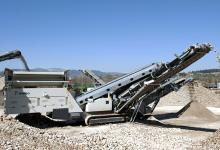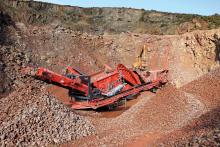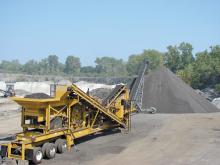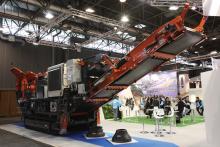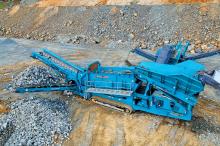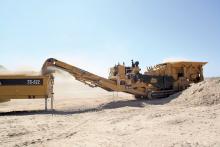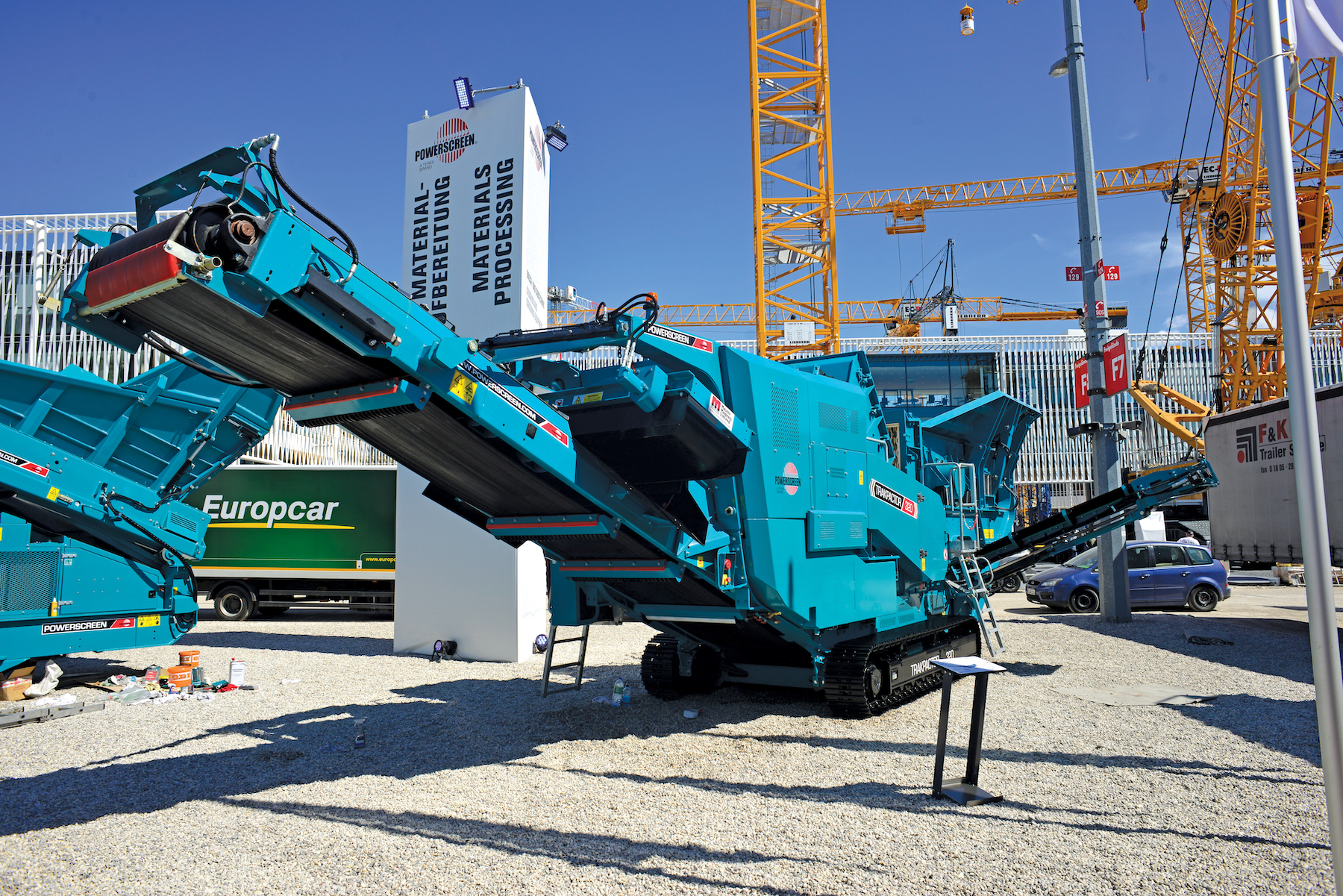
Recent exhibitions have been launch venues for key developments in aggregate production technologies - Mike Woof reports
Efficient production of aggregates is crucial for maintaining cost-effectiveness and also lowering material costs. With contractors owning many of their own quarry operations, these firms understand the benefits of reducing materials costs for their road construction projects. Major developments in the equipment for crushing, screening and washing aggregates are now coming to market and ensuring quarry companies can further optimise their operations.Advances in crushing systems offer improvements in quarrying efficiency and various firms have introduced new models for the primary and secondary crushing sectors.
Suitable for both primary and secondary crushing applications, the sizer has shafts with exchangeable crushing segments. The centre distance of the crusher rolls is adjustable to provide accurate sizing of materials. Feed size for limestone or clay is 0-350mm, with final product size of up to 80mm. The sizer can handle up to 250tonnes/hour of limestone or 350tonnes/hour of clay.
Ohio-based manufacturer
Power comes from a 261kW
Performance and production are said to be improved and enhanced by the four-bar impactor design, which optimises production and minimises uneven wear on the blow bars. The blow bars can be removed, turned around and reinstalled increasing life while adjustable aprons are used to control the size of the crushed material. The firm fits AR-400 steel plate liners for each material transfer point, which increases durability over rubber liners used by other manufacturers. To reduce cleaning and maintenance needs, the RDS-15 features a standard dust suppression system. For further protection from dust and vibration of normal operating conditions, operators can remove the machine’s control panel for remote operation.
Designed for use as a primary crusher, the wheeled WJC-2644 jaw crusher is capable of processing hard rock, recycled concrete, sand and gravel. Power comes from a 261kW Caterpillar C-9 diesel and the WJC-2644 can produce up to 333tonnes/hour.
Providing a capacity of 8.24m3, the hopper on the unit is said to be larger than those on competing units. A spokesperson said, “We made the conveyor larger and higher so we get more stockpiling capacity.”
The wheeled chassis makes the machine easy to transport and the spokesperson said, “It’s all about portability. We put six legs on it and you can just jack it up on-site.” The spokesperson added the transport regulations are tough in Ohio and as the machine meets these requirements, users should be able to move the plant by road in most countries.
The stepped chassis raises the screenbox higher, a layout that increases production by up to 20%. A hydraulic adjusting chamber allows operators to adjust crushing size and the machine has a grizzly bypass conveyor with an adjustable flop gate, as well as a feeder with a grizzly bar section. These features ensure that material, depending on its size, is properly classified and directed to either the side discharge conveyor or the crusher discharge. The spokesperson added, “It’s cheaper to buy and maintenance costs less but you still get the productivity of a larger machine.
The continuous feed system (CFS) controls an even more equal loading of the crushing area, in which the conveying frequencies of the feeder trough and the pre-screen are adapted independently of each other to the level of the crusher and, thus, help increase the performance significantly.
The new crusher has a hoisted articulated crusher jaw, which prevents blocking of coarse material and takes all fastening elements of the crusher jaw from the wear area. In addition, the transfer from the pre-screen or the feeder trough is designed so that the material can tilt into the crushing jaw and convey an even material flow.
International sales have been achieved by the firm in Latin America and the Middle East and the company hopes to further capitalise on this with the availability of the new GT model.
New from RubbleMaster is the RM100 GO! tracked mobile impact crusher. The machine has a throughput capacity of 200tonnes/hour and has a 900x750mm inlet opening, three rotor speeds and is available with two, three or four hammers. The 29tonne John Deere-powered machine has a 3m loading height, an asymmetric vibro feeder and a pre-screen measuring 1,500x900mm. It is fitted with a 1m-wide main discharge belt and has a stockpiling height of 3.3m. Screened discharge is via 500mm-wide belt with a 2.4m discharge height. Set up with Rubblemaster’s GO! Machines, the operator simply pushes the button and the machine is available for work almost immediately, while standardised remote control allows users to operate all relevant functions.
Meanwhile
Based on a robust crusher chassis, the QE341 mobile scalper has been designed for two-way or three-way split configurations, along with reversible side conveyors for versatility. A screen box jack-up facility makes it easier to access the bottom deck for maintenance and for screen changes. The electrical control system incorporates a colour-coded numerical push button control with a display to allow the operator to monitor production. An auto start/stop feature, pre-start warnings on all plant functions and a three-mode selector are also incorporated with the controls. Radio-control is standard on the QE341.
And
Equipped with a 9.6m3 hopper, with self-locking mechanism to speed set-up and teardown, the machine has a transport weight of 45tonnes.
Terex Finlay has also launched the I-100 direct-drive horizontal-impact crusher with variable speeds for both quarrying and recycling applications. The machine is equipped with an electronic control system that monitors and controls the speed of the rotor and regulates the heavy-duty vibrating feeder with integrated pre-screen, to maintain a consistent feed of material. Standard hopper capacity is 2.3m3 and the company claims that the I-100 requires minimal set-up time. Radio remote control is available as an option.
Screening systems
Developments in screening technologies are also improving quarry operations. Major Wire Industries has been a pioneer in developing new screen deck materials and its Flex Mat system is said to offer several benefits. A spokesperson for the firm said, “What makes Flex mat different is it’s not woven and we use polyurethane strips to hold it together. Because of this it’ll flex, which eliminates pegging and clogging as the crosswires vibrate.”The spokesperson continued, “It’s not woven so there are no high spots that wear and there’s no embedded steel so it bends. We have a new panel that can replace any polyurethane or rubber panel.”
According to the firm, the new Double-Weave woven wire features two, side-by-side, lighter-gauge wires and is said to outperform heavy-gauge, single-strand woven wire and perforated punch plate in high-impact applications. Impact from large aggregate material can cause screen breakage with even the heaviest single wire gauges. Woven with two smaller-diameter wires, Double-Weave screen media has lower wear points than larger, single-strand wire; one wire helps preserve the life of the other as it wears. The combined tensile strength of the two finer-gauge wires withstands up to four times greater impact providing up to 40% greater wear life than that of one heavy-gauge wire. Double-Weave also weighs less and is more flexible than single heavy-gauge screen media, so it is easier and safer to install. Compared to perforated punch plate, Double-Weave has far more open area, increases throughput up to 50% without costly screen deck alterations and costs up to 25% less. In addition, Double-Weave provides up to an additional 40% more wear life because it is manufactured with abrasion-resistant OptimumWire, a high carbon and high manganese content material. It is also available in stainless steel, which helps reduce blinding in sticky material applications. Producers can choose opening sizes from 31.8-127mm and wire diameters from 6.2-12.7mm.
WS Tyler is now offering its consultative Pro-Deck approach to vibrating screens using modular screen media. This allows customers to benefit from the flexibility of modular panels in combination with the Pro-Deck approach for extended screen life and higher production rates. The Pro-Deck package includes an audit of the entire machine using sensors installed in the equipment to analyse the performance of components such as bearings. A spokesperson said, “You have to make sure it’s working as well as possible.” Factors such as the type of screen media can be assessed and then changed if necessary so as to optimise the whole equipment package.
The company said that using Pro-Deck allows different style screen panels to be used so as to optimise both wear life and open area. This process uses the firm’s vibration analysis techniques and allows the use of multiple types of screen media on a single deck, instead of using the same screen media. The company carried out extensive research and years of experience and this showed that more than one type of screen media extends the life of the screen media while also increasing efficiency. Additionally, the Pro-Deck approach helps eliminate common screening problems such as blinding, pegging and premature wear that cause unscheduled downtime.
Meanwhile McCloskey is introducing a highly mobile, high performance, tracked trommel screen designed for versatility. The new 516RT can be used for processing a range of materials and in different applications. Weighing in at 22.5tonnes, the 516RT boasts a heavy duty chassis with four independent stabiliser jack legs, integrated hydraulic folding conveyors and a radial conveyor with 180° swing that delivers 4.13m stockpile height. Power comes from a Caterpillar C4.4 diesel rated at 75kW and the machine has a longer and wider direct feed hopper than its competitors, providing a large loading area. Its wide feed opening allows for the free flow of material and high volume capacity and the machine minimises material spillage while its rubber belting extends along the length of the machine and reduces blockages, even when with wet and sticky materials.
For heavy duty applications, a remote control hydraulic tipping grizzly can be added to scalp off large material. As with all McCloskey equipment, the 516RT has an accessible engine service bay for ease of maintenance and service, saving time and reducing costs. Additional options include a radio remote control for tracks, a variety of drum and screen combinations, and a hydraulic tipping grid.
Optimising equipment
One of the key developments for optimising the efficiency of a quarrying facility has been the development of the
The new version, AggFlow 400, provides additional features including corporate networking and sharing, personal and corporate databases for gradation and equipment and project tracking and approval processes. It also includes production scheduling capabilities as well as a new range of wash and water equipment functions. “I cannot really get into specifics at this moment, but I can say that customers who use the program will be blown away by the new features and attributes of 400. It is simpler, easier and more powerful than ever,” said Ryan Stormont, BedRock’s head of US sales.
The company is offering a new program that will run on an internet-based system that can be used by dealers and stone producers. Because these dealers and producers have a constant demand for new layouts to be used in new projects the latest package is aimed at these specific design needs. The company said that producers will be able to simulate a plant and define operating modes using this plant management capability, with multiple users looking at the information. The users can share information with each other and it is also possible to designate access levels to the system ranging from read-only up to full control. Users will also be able to enter sales forecasts and the package will then perform calculations that will optimise plant operation accordingly.“Essentially, it’s lifting us out of a single computer to an internet-based system,” said a company representative. “You can still run it remotely as a single system but the core data is saved on the server. If you lose your computer, you don’t lose your data and it’s extremely fast and will allow users to share more information.”
Further optimisation of quarry operations can be provided with a new system from Italian company
The other benefit of Fuel Q-Control, said di Agostini, is that it allows the user to calculate the average fuel consumption of each machine, which helps with planning and preventative maintenance. Meanwhile the Maintenance Q-Control package is a maintenance management system that allows the quarry owner to schedule maintenance and also to record unscheduled maintenance.
“Maintenance can take up to 15% of a quarry operator’s cost,” said di Agostini. “Unscheduled maintenance is usually a ‘hidden cost’ because it is never recorded and by the end of the year it is forgotten about.” With Maintenance Q-Control, every time an operator carries out maintenance he can record it using a touchscreen.
Organising preventative maintenance will reduce unscheduled downtime and provide major cost savings according to di Agostini. “Operators often forget about preventative maintenance so the machine will break down, putting the plant out of action. Accurate planning of maintenance can prevent this happening.”
Both Fuel Q-Control and Maintenance Q-Control can be used with Ma-estro’s automation system, Automation Q-Control, or linked up with other makes of automation system. There is a one-off charge for the software and then a yearly fee if users want to store information on Ma-estro’s cloud; larger contractors often choose to store their own data, said di Agostini.

